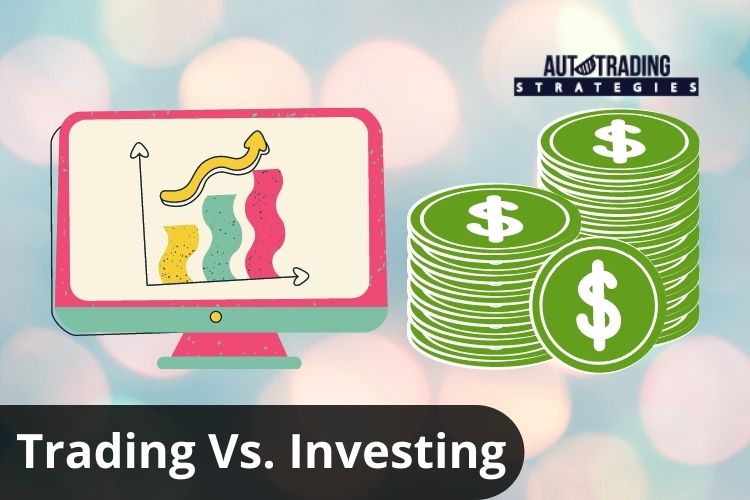When someone says the word ‘trading‘ the scene of a stock market comes into our head. People standing or sitting in front of screens and watching every red/green number closely.

This is how stock trading used to happen back in the day. Traders had to physically go to the stock market. The buyer and sellers would meet in person and do deals by yelling prices on the trading floor.
These days the internet revolution has changed the way trading is being carried out. The online operation of stock exchanges has allowed investors to trade stocks online. All you need to do is sit in front of the computer and execute the buy/sell orders.
The terms ‘trading‘ and ‘investing‘ are often interchangeably used in the financial world. However, both of these are different in nature. Trading is a short term strategy for making money. Whereas, investing is a long game. In this blog, we will succinctly describe the difference between trading and investing for the audience’s understanding.
Table of Contents
Basic Concept
Trading is the act of buying or selling your investment for short-term benefit.
Investment involves the act of spending your cash for earning a percentage of profits or a larger benefit in the future.
The techniques of trading and investing are similar. However, the approach and intent behind both is very different.
Approach
Trader intends to make money in a small amount of time. He/she buys and sells stocks frequently. For instance, a cryptocurrency day trader will execute multiple order within a single day to make money from a small price difference.
Interesting For You: How to Become a Professional Day Trader
The investor’s approach is more stable. He/she puts money into an asset for instance a house or piece of land. He/she profits from the value of that asset growth over time.
Trader relies on market volatility. On the other hand, the investor is in for market appreciation over a long period of time.
Timing
As mentioned earlier, investing involves betting on an asset for a long time. If you invest in Tesla’s stocks today, you are mainly expecting that the stock price will grow in 5, 10 or even 20 years. Although investors tend to buy the stocks when their price is lower, they do not concern themselves with the day to day price fluctuation. The presupposition is that the price of the stock will grow either by asset base or profit.
Trading happens in short time spans. A trader has a fast and furious approach. He/she benefits from price swings within a day or even hours. Thus, traders take multiple positions within a short span of time.
Analysis
Traders and investors distinctly analyze the assets for investment. The difference in approach here depends on the stock’s price and its intrinsic value.
The price of an asset depends on the numbers of buyers and sellers trading it at some particular time. You would have heard that often price of assets changes depending on the fear or greed in the market.
Intrinsic value is what the asset is really worth. The price eventually starts to follow the intrinsic value of the asset. However, market sentiments can deviate the price from its true worth.
Also Read: Best Day Trading Strategies in 2021
Tools of Investing
Investors look at all the information related to an asset to gauge its true intrinsic value. There is a heavy focus on market fundamentals such as price-earning ratios of the company and management forecasts.
Passive investors do not bother themselves with the price of an asset. They know that the intrinsic value of the stock will rise in the long run. Therefore, even buying an over-priced asset will benefit them at some point.
Active investors buy the stock when its price is down. Thus, they benefit from the rising intrinsic value as well as price fluctuation.
Tools of Trading
Traders mantra is different from investors. They only care about the price of an asset. Many times traders don’t even know the work of a company whose stocks they are buying. Hence, there is no attempt to find out the intrinsic value of the investment.
Due to the heavy focus on ‘buy low, sell high’ traders tend to analyze the asset’s price through technical analysis. Technical indicators such as Moving Averages, Oscillators, and Support/Resistance are analyzed through charts. You might be familiar with the trader’s setup of four screens.
Traders look for price patterns and trends. The patterns are a way to see what happened before and to guess what will happen again. With past knowledge of price movements, traders are better equipped to deal with market volatility.
The small, short-term price swings keep the traders going. Often investors also watch out for news related to an asset. This helps in guessing the price trend. For instance, the news of tesla investing 1.5 billion dollars in bitcoin was positive for the future of BTC. Traders who bought bitcoin following this revelation were able to earn profit as the price of one bitcoin went to 48,000 dollars afterwards.
Traders do focus on asset-related data to some extent. Nevertheless, a deep analysis of the market is neither needed nor required.
Goal Of Traders Vs. Investors:
The goal of traders is to earn frequent profit by buying and selling stocks, commodities, currency pairs, and other financial instruments. The returns need to outperform buy-and-hold investments. A trader may seek to earn up to 20% profit each month as he has to re-invest quickly. Besides, the trader takes a time-bound position.
Investing involves buying and holding positions for a longer period of time. The investor’s goal is to increase wealth gradually by holding on to financial instruments with growing intrinsic value. Investments are held for a period of years and sometimes decades. Investors are usually content with a 10%-20% return over the year.
Pros and Cons of Trading Vs. Investing:
Trading and investing are strategies for earning profits through one’s investment. Traders, oftentimes, are more aware of the market movements than investors.
Pros of Trading:
- Trading is easy and convenient. You can trade in the stock market promptly and efficiently.
- You can start with a small budget and grow your income exponentially in a relatively short period of time.
- Online traders can earn up to 20% profit on their trades in a single month. Such returns can become a monthly income source. Thus, traders can choose trading as their full-time job.
Cons of Trading:
- Trading can be exhausting. Earning small rewards requires you to stare at the screen all day long.
- A lot of betting is involved in trading. You buy a stock expecting its value to rise shortly afterwards. However, markets are unpredictable. Thus, there is a high risk of losing money.
- Professional traders and algorithmic trading bots have an edge over the new fish. A beginner trader may not stand a chance of winning in front of big players.
Pros of Investing:
- Investors take advantage of a growing economy. When you buy stocks of a company then the growth of that company means your assets’ worth will also increase.
- Inflation has been on the rise for decades. Subsequently, stock prices increase every year. Thus investors stay ahead of inflation with investment.
- Investors can sit on their investments for months or years. No need to analyze market prices 24/7.
- Investment helps you make money in two ways. First, from the rising intrinsic value of the stock. Secondly, by exploiting the market sentiment and buying low.
Cons of Investing:
- Investing requires big capital to start.
- The risk factor is also higher in investing. You can lose big.
- Investments are held for the long term. Hence, it is time taking effort.
Closing Thoughts:
Trading and investing are ideal for different types of individuals. Trading requires quick thinking and prompt execution of orders. Whereas investing requires deep analysis. Both have different time lengths as well. A person should choose either trading or investing, based on the size of his capital, financial freedom and emotional discipline.
